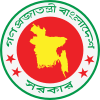Sylhet
Sylhet (Bengali: সিলেট), is a metropolitan city in northeastern Bangladesh. It is the administrative seat of Sylhet Division. The city is located on the right bank of the Surma River in northeastern Bengal. It has a subtropical climate and lush highland terrain. The city has a population of more than half a million.[2] Sylhet is one of Bangladesh's most important spiritual and cultural centres. It is one of the most important cities of Bangladesh, after Dhaka and Chittagong due to its importance to the country's economy. Sylhet produces the highest amount of tea and gas in the country.
Sylhet সিলেট ꠍꠤꠟꠐ | |
|---|---|
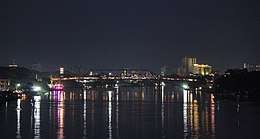  .jpg)    From the top:Sylhet Skyline with Keane Bridge, Osmani International Airport, Sylhet railway station, Sylhet Circuit House, Shah Jalal, Sylhet International Cricket Stadium. | |
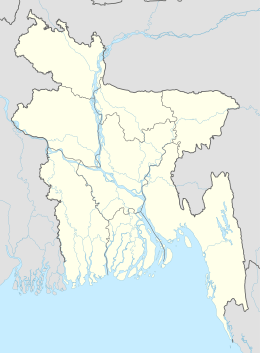 Sylhet Location of Sylhet in Bangladesh  Sylhet Sylhet (Asia) .svg.png) Sylhet Sylhet (Earth) | |
| Coordinates: 24°54′N 91°52′E | |
| Country | |
| Division | Sylhet Division |
| District | Sylhet |
| Municipal Board | 1867 |
| Sylhet City Corporation | 9 April 2001 |
| Metropolitan city | 31 March 2009[1] |
| Government | |
| • Type | Mayor–Council |
| • Body | Sylhet City Corporation |
| • City Mayor | Ariful Haque Choudhury (BNP) |
| Area | |
| • Urban | 26.5 km2 (10.2 sq mi) |
| • Metro | 518.43 km2 (200.17 sq mi) |
| Elevation | 35 m (115 ft) |
| Population (2011) | |
| • Metropolis | 526,412[2] |
| • Density | 19,865/km2 (51,450/sq mi) |
| Demonym(s) | Sylheti |
| Time zone | UTC+6 (BST) |
| Postal code | 3100 |
| Police | Sylhet Metropolitan Police (SMP)[3] |
| International airport | Osmani International Airport |
| Regional Calling code | +880821 |
| Website | scc |
The name of Sylhet is the anglicized form of the ancient Indo-Aryan term Srihatta.[4] In 1303, the Sultan of Lakhnauti Shamsuddin Firoz Shah conquered Sylhet by defeating Gour Govinda.[5] Sylhet was a realm of the Bengal Sultanate. In the 16th-century, Sylhet was controlled by the Baro-Bhuyan zamindars and later became a sarkar (district) of the Mughal Empire.[6] Sylhet emerged as the Mughals' most significant imperial outpost in the east and its importance remained as such throughout the seventeenth century.[7] British rule began in the 18th century under the administration of the East India Company. With its ancient seafaring tradition, Sylhet became a key source of lascars in the British Empire. The Sylhet municipal board was established in 1867.[8] Originally part of the Bengal Presidency and later Eastern Bengal and Assam; the town was part of Colonial Assam between 1874 and 1947, when following a referendum and the partition of British India, it became part of East Bengal.[5] The Sylhet City Corporation was constituted in 2001. The Government of Bangladesh designated Sylhet a metropolitan area in 2009.[9]
The hinterland of the Sylhet valley is the largest oil and gas-producing region in Bangladesh. It is also the largest hub of tea production in Bangladesh. It is notable for its high-quality cane and agarwood.[4][10] The city is served by the Osmani International Airport which is named after General M A G Osmani, the Commander of the Bangladesh Liberation Forces. People from Sylhet form a significant portion of the Bangladeshi diaspora, particularly in the United Kingdom and the United States, as well as other countries in the Middle East.
Toponymy
The name Sylhet is anglicized from Srihatta. In Indo-Aryan languages, Sri means prestige or beauty. Hatta (Haat) is a term for a marketplace. The name of the region was changed to Jalalabad during the Sultanate period, but the actual town of Srihatta kept its name. In the Mughal Empire's records, Srihatta was used as the name for the city in the Bengal Subah.[11] In British India, Srihatta became known as Sylhet in English.
History
In 1995, the Government of Bangladesh declared Sylhet as the sixth divisional headquarters of the country.[12] Sylhet has played a vital role in the Bangladeshi economy. Several of Bangladesh's finance ministers have been Members of Parliament from the city of Sylhet. Badar Uddin Ahmed Kamran was a longtime mayor of Sylhet. Humayun Rashid Choudhury, a diplomat from Sylhet, served as President of the UN General Assembly and Speaker of the Bangladesh National Parliament.
In 2001, the municipality was upgraded to the Sylhet City Corporation. It was made a metropolitan city in 2009.[9]
Geography and climate
Sylhet is located at 24.8917°N 91.8833°E, in the north eastern region of Bangladesh within the Sylhet Division, within the Sylhet District and Sylhet Sadar Upazila. Sylhet has a typical Bangladesh tropical monsoon climate (Köppen Am) bordering on a humid subtropical climate (Cwa) at higher elevations. The rainy season from April to October is hot and humid with very heavy showers and thunderstorms almost every day, whilst the short dry season from November to February is very warm and fairly clear. Nearly 80% of the annual average rainfall of 4,200 millimetres (170 in) occurs between May and September.[13]
The city is located within the region where there are hills and basins which constitute one of the most distinctive regions in Bangladesh. The physiography of Sylhet consists mainly of hill soils, encompassing a few large depressions known locally as "beels" which can be mainly classified as oxbow lakes, caused by tectonic subsidence primarily during the earthquake of 1762.
Geologically, the region is complex having diverse sacrificial geomorphology; high topography of Plio-Miocene age. Available limestone deposits in different parts of the region suggest that the whole area was under the ocean in the Oligo-Miocene. In the last 150 years three major earthquakes hit the city, at a magnitude of at least 7.5 on the Richter Scale, the last one took place in 1918, although many people are unaware that Sylhet lies on an earthquake prone zone.[14]
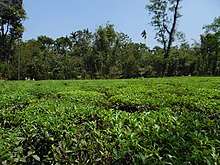

| Climate data for Sylhet, Bangladesh | |||||||||||||
|---|---|---|---|---|---|---|---|---|---|---|---|---|---|
| Month | Jan | Feb | Mar | Apr | May | Jun | Jul | Aug | Sep | Oct | Nov | Dec | Year |
| Average high °C (°F) | 25.2 (77.4) |
27.1 (80.8) |
30.4 (86.7) |
30.8 (87.4) |
30.8 (87.4) |
30.9 (87.6) |
30.9 (87.6) |
31.6 (88.9) |
31.2 (88.2) |
30.9 (87.6) |
29.2 (84.6) |
26.3 (79.3) |
29.6 (85.3) |
| Average low °C (°F) | 12.9 (55.2) |
14.2 (57.6) |
18.1 (64.6) |
20.8 (69.4) |
22.6 (72.7) |
24.4 (75.9) |
24.9 (76.8) |
25.0 (77.0) |
24.3 (75.7) |
22.5 (72.5) |
18.4 (65.1) |
14.0 (57.2) |
20.2 (68.3) |
| Average rainfall mm (inches) | 8 (0.3) |
31 (1.2) |
146 (5.7) |
372 (14.6) |
569 (22.4) |
796 (31.3) |
834 (32.8) |
621 (24.4) |
548 (21.6) |
232 (9.1) |
30 (1.2) |
13 (0.5) |
4,200 (165.1) |
| Source: WMO[15] | |||||||||||||
Administration
Sylhet is divided into 6 metropolitan thanas(police station) and consists of 27 wards and 224 mahallas. The thanas are:
- Bimanbandar Thana
- Kotwali Thana Google Maps
- Jalalabad Thana Google Maps
- Dakshin Surma Thana Google Maps
- Mogla Bazar Thana Google Maps
- Shah Paran Thana
It is a small city with an area of 26.50 km2.[16] The rapid growth and expansion of Sylhet occurred during the colonial period. Sylhet Municipality was established in 1878. A devastating earthquake demolished almost the entire town on 12 June 1897 following which a modern and European model new town was built on the wreckage. Many new roads were constructed in the late 1890s and Sylhet became really connected to the other parts of the country with the establishment of an extension line of Assam Bengal Railway in 1912–15. From the beginning of the 20th century, the importance of Sylhet increased with the establishment of the tea industry. In the 1950s and 1960s, rapid urbanisation took place in the town, fostered by the expatriate Sylhetis and the process is still ongoing.
On 10 April 2001, Sylhet was changed to a city corporation from a municipal board, and currently the city is administrated by the Sylhet City Corporation. At present, Sylhet is the district-headquarters as well as the divisional headquarters of the districts of Sunamganj, Habiganj, Moulvibazar and Sylhet District. The Sylhet City Corporation is responsible for the services that are provided within the city which includes traffic, roads, garbage collection, water supply, registrations and many others. The corporation consists of the Mayor and 22 other commissioners, and focuses on the development of the city.[17]
Military
Sylhet is strategically important for the Bangladesh Armed Forces. The Bangladesh Army's 17th Infantry Division is based at Jalalabad Cantonment in Sylhet.[18] The cantonment is also home of the School of Infantry and Tactics (SI&T) and the 1st Para-commando Battalion, an elite commando unit of the Bangladesh Army.
Healthcare
Sylhet is also home to many hospitals that strategically provide healthcare to the community such as the Shahid Shamsuddin Hospital District Hospital, Sylhet MAG Osmani Medical College, Jalalabad Ragib-Rabeya Medical College, North East Medical College, Sylhet Women's Medical College, Parkview Medical College, Ibn Sina Hospital Sylhet Ltd, Noorjahan Hospital (pvt) Ltd, Oasis Hospital, Mount Adora Hospital, Square Medical Service, Popular Medical Service, Medinova Medical Service, Labaid Ltd and the Mohanagar Hospital as well as world's leading five star hospital such as the Al Haramain Hospital.[19]
Presently Sylhet Medical University Established In The Sylhet City. According to the Prime Minister's order to strictly monitor whether medical standards are being properly maintained in medical colleges, a medical university will be set up in each division. According to the order, Chittagong and Rajshahi Medical University have already been established. Sylhet Medical University is the 4th Medical University of the directive.[20][21]
Demographics
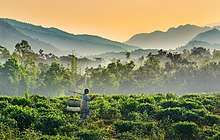
According to the 2011 Bangladesh census, the city had a population of 531,663.[2] The population growth rate of the city is 1.73%, which has reduced from 1.93% in 1991.[22] As of 2001, It had average literacy rate of 69.73%.[23] The highest literacy rate was 84.24% in Ward 22 and the lowest was 48.15% in Ward 10 (2001). The total number of households in the city was 55,514.[16]
The majority of the population are of Bengali Muslims of Sylheti background, while there are significant minority groups which includes the Bishnupriya Manipuri and others.[24]
Sylheti is spoken by the vast majority of the people, while standard Bengali is the official language used by the state government and officials.[25][26][27]
The majority of Sylhetis are Muslims (87.2%), other religious groups include Hindus (12.6%) and less than 0.2% of other religions, mainly Buddhists and Christians.[2] The majority of the Muslims are mainly Sunni Hanafi;[28] and there are significant numbers of people who also follow Sufi ideals, the most influential are the teachings of Abdul Latif Fultali.[29]
Diaspora
In the United Kingdom, the 2001 Census found 283,000 people of Bangladeshi heritage, 154,000 of whom were Bangladeshi-born.[30] As of 1986, an estimated 95% of Bangladeshis living in the United Kingdom were from Sylhet Division.[31] They are concentrated in the boroughs of East London, having established themselves within the communities, notably in the vicinity of Brick Lane which has been dubbed as Banglatown.[32][33][34] Sylheti expatriates are known as "Londoni" in Sylhet.[29][35] Many have also emigrated to the United States, they are mainly spread out across the country but have a large concentration in New York City, Buffalo, Detroit and Los Angeles.[36][37] Many Sylhetis have also emigrated to Canada, France, Australia, Spain, Germany, Sweden and other European countries. Tens of thousands of Sylhetis are also working as guest workers in the Middle Eastern Gulf states.[38][39]
Sylhet has a "Friendship Link" with the city of St Albans in the United Kingdom. The link was established in 1988 when the District council supported a housing project in Sylhet as part of the International Year of Shelter for the Homeless. Sylhet was chosen because it is the area of origin for the largest ethnic minority group in St Albans.[40] In July 1996, the mayor of Sylhet, Badar Uddin Ahmed Kamran, signed the twinning accord between Sylhet and the London Borough of Tower Hamlets (home to around 55,000 Sylhetis at the time), with the mayor of Tower Hamlets, Albert Jacobs, in London.[41] Sylhet has played a vital role in the Bangladeshi economy. Several of Bangladesh's finance ministers have been Members of Parliament from the city of Sylhet. Badar Uddin Ahmed Kamran was a longtime mayor of Sylhet. Humayun Rashid Choudhury, a diplomat from Sylhet, served as President of the UN General Assembly and Speaker of the Bangladesh National Parliament.
In 2001, the municipality was upgraded to the Sylhet City Corporation. It was made a metropolitan city in 2009.09.</ref> In March 2009, the Mayor of Sylhet, Badar Uddin Ahmed Kamran, signed a Memorandum of Understanding (MoU) to form another Friendship Link between Sylhet and the Metropolitan Borough of Rochdale, home to around 10,000 people with Sylhet heritage, with the Mayor of Rochdale Cllr Keith Swift at the Sylhet City Corporation
Economy

The Sylhet Metropolitan Area is one of Bangladesh's main business centers. Sylhet's economy is closely linked with the Bangladeshi diaspora, especially the British Bangladeshi community. The city receives a significant portion of the country's annual remittances, which have driven growth in real estate and construction.[42] A number of shopping centers, restaurants and hotels have opened as a result. Sylhet also relies on religious tourism, with thousands of devotees visiting its Sufi shrines annually, as well as ecotourism in its broader natural hinterland. Nature resorts have been built in the city's outskirts. Several important Bangladeshi companies are based in Sylhet, including Jalalabad Gas Transmission and Distribution, Sylhet Gas Fields and Alim Industries. Biman Bangladesh Airlines operates several flights from Sylhet to the United Kingdom and the Middle East. Roads connect Sylhet with the Indian states of Meghalaya and Assam.
Sylhet's hinterland plays a vital role in the economy of Bangladesh. It is home to the country's largest natural gas fields, sole crude oil field,[43] largest tea plantations, rubber, palm oil, cane, agarwood[10] and citrus farms. Rice production in the region is one of the country's highest. Heavy industries include power plants, fertilizer plants, cement plants and liquefied petroleum gas plants. Other major industries in the region include ceramics, machinery and equipment, ready-made garments and pharmaceuticals. Most of the tea production in Bangladesh is based around Sylhet, and the industry also has significant exports. The area is also known for producing oranges and other similar fruits. One of these fruit is called "Satkara" which is a variety of grapefruit that can be used in pickles and even as an ingredient in traditional Sylheti curry dishes.
Two Bangladeshi finance ministers from the city have been elected to the Jatiyo Sangshad: Saifur Rahman of the Bangladesh Nationalist Party and Abul Maal Abdul Muhith of the Awami League.The present foreign affairs minister DR. A K Abdul Momen who is also the younger brother of the former finance minister Abdul Muhith represents the parliamentary seat sylhet-1 in the jatiyo sangsadm
Utility
Sylhet has high rates of electric power shortage and water shortage. According to the Power Development Board, Sylhet is only receiving 50 MW, which is half if the required demand of 100 MW. The city corporation is also supplying only 22,500 gallons of water, far less than the demand of about 65,000.[44] The major sources of water to the city is the tube wells and the Surma River. Tests of tube wells in Sylhet District by the Bangladesh University of Engineering and Technology in 1997 found that about 27.6% contained more arsenic than the acceptable limit set by Bangladesh of 50 micrograms per liter, and 49.2% contained more arsenic than the World Health Organization standard of 10 micrograms per liter.[45] There are about 331 registered restaurants in the city, only 15% maintain sanitary facilities and 85% have unhygienic conditions that are unsafe for the public.[46]
Culture
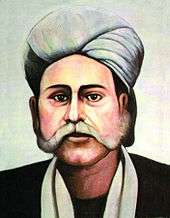
Sylhet has a very diverse culture which is noticeably distinct from that of Bengali owing to the influx of multi-ethnic immigrants in ancient times. There is a widely held misconception through which Sylhetis are usually seen as having a conservative mindset; a very inaccurate portrayal of Sylhetis and their culture, while in reality it's quite the opposite thanks to Sylheti culture's liberal and pro-plurality outlook. Sylhet is religiously very diverse, and is noted for peaceful co-existence, harmony, and mutual respect between its inhabitants of different faiths since ancient times. Sylhet has a distinct cultural and economic development, and linguistic differences (Greater Sylhet region was a part of Assam and Surma Valley State for much of the British Raj in comparison to the rest of Bangladesh), and given that Sylhet has, for most of its recent history, been a region of a larger entity.[47][48] As so many Sylhetis are resident abroad, Sylhet has a major flow of foreign currency from non-resident Bangladeshis. The major holidays celebrated in Sylhet include traditional and religious celebrations.[49][50] Cultural or nationalistic celebrations include the Language Movement Day, this is where wreaths are laid at the Shaheed Minar paying tribute to the martyrs, the Bangladeshi Independence Day, Victory Day celebrated with parades by school and academies, and the Pohela Baishakh—celebration of the Bengali New Year. Marriages are practised in a traditional Sylheti Muslim style, Sini faan ( Engagement[51]) with the Gaaye halud (haldi or turmeric ceremony), Mehndi (henna ceremony) Akht (Nikah or Muslim way of marriage), Bidaai (Rukhsati/baraat or the farewell of bride), walima (reception) holy prayers. The traditional dance of Sylhet is called Sylheti Dhamail.
Sports

Cricket is the most popular sport in Sylhet. Bangladesh Premier League franchise Sylhet Sixers are based in Sylhet International Cricket Stadium (M.A.G. Osmani Stadium), which was built in 2007 and has a capacity of 18,500 spectators. The Sylhet International Cricket Stadium was renovated in 2013 especially to host matches of 2014 ICC World Twenty20. It is situated near lush green tea gardens on the city fringe.[52] In the National Cricket League Sylhet Division has not won any titles however did win in the One-Day Cricket League in 2001–02 season. Notable players from Sylhet who have played for the Bangladesh national cricket team include Rajin Saleh,[53] Enamul Haque Jr,[54] Tapash Baisya,[55] and Alok Kapali.[56] Chess player Rani Hamid was awarded the FIDE Women's International Master (WIM) title in 1985.
Transport


The main transport systems used in the city are cycle rickshaws, auto rickshaws (mainly known as baby-taxis or CNGs), buses, mini-buses and cars. There are about 80,000 rickshaws running each day. Bus service prices have increased as of 2008, up to 30% higher, prices ranges from Tk 4 to 15.95.[57]
The N2 is the national highway that connects the city with country's capital and largest city Dhaka as well as with many other parts of the country. The N2 highway is also part of AH1 and AH2- two longest routes of the Asian Highway Network.
Air
The city of Sylhet is served by Osmani International Airport, located at the north of the city. It is Bangladesh's third busiest airport and became an international airport due to the demand of expatriate Bangladeshis and their descendants from the United Kingdom and the United States. The main frequent airlines of the airport are Biman Bangladesh Airlines, Flydubai, United Airways, US-Bangla Airlines and Novoair. The airport received its first international arrival on 3 November 2002, with Biman arriving from Kuwait via Abu Dhabi en route to Dhaka.[58] Meanwhile, it received first direct international arrival on 15 March 2017 as a direct flight of Dubai based carrier Flydubai landed at the airport.[59] Work started in 2006 to upgrade the airport to international standards, including a new terminal building, a jetway, a taxiway, and expansion of the runway to accommodate wide-bodied aircraft.[60] It was confirmed that in May 2007, Biman will be operating Hajj flights directly from the airport later in 2007.[61] Government will construct a 34,919 square-metre high-quality international passenger terminal building, cargo building, control tower, parking, taxiway and other important infrastructures to meet the growing demand in line with the increase of passengers and cargo transportation at the airport.[62]
Rail
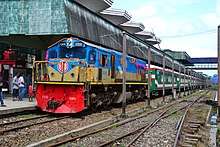
The Sylhet Railway Station is the main railway station providing trains on national routes operated by the state-run Bangladesh Railway. Some important train that origins/terminates :
Towards Dhaka
| Train No. | Train Name | Train Type | Departures |
|---|---|---|---|
| 710 | Parabat Express | Intercity | Daily (except Tue) |
| 718 | Jayantika Express | Intercity | Daily |
| 740 | Upaban Express | Intercity | Daily |
| 774 | Kalni Express | Intercity | Daily (except Fri) |
| 10 | Surma Mail | Daily | |
Towards Chittagong
| Train No. | Train Name | Train Type | Departures |
|---|---|---|---|
| 724 | Udayan Express | Intercity | Daily (except Fri) |
| 720 | Paharika Express | Intercity | Daily (except Fri) |
| 14 | Jalalabad Express | Daily | |
Towards Akahura
| Train No. | Train Name | Train Type | Departures |
|---|---|---|---|
| 18 | Kushiara Express | Daily | |
Education
There are two public universities in Sylhet: Shahjalal University of Science and Technology and Sylhet Agricultural University.[63] There are some prominent colleges in Sylhet such as Jalalabad Cantonment Public School and College, MAG Osmani Medical College, Sylhet, Sylhet Women's Medical College, North East Medical College, Sylhet Engineering College,[64] Sylhet Cadet College, Murari Chand College,[65] Institute of Health Technology, Sylhet, Scholarshome, Sylhet Science And Technology College and Sylhet Polytechnic Institute, Sylhet Government Women's College
Notable people
See also
- Sylheti language
- Sylheti Nagari
- Barak Valley
References
- "Bangladesh clamps down on beggars". BBC News. 2 April 2009. Retrieved 2 April 2009.
- "National Volume-3: Urban Area Report" (PDF). Population and Housing Census 2011. Bangladesh Bureau of Statistics. August 2014. pp. 25, 48. Archived from the original (PDF) on 18 May 2015.
- "Sylhet Metropolitan Police". sylhetmetropolitanpolice.com.
- https://www.britannica.com/place/Sylhet
- Tanweer Fazal (2013). Minority Nationalisms in South Asia. Routledge. p. 53. ISBN 978-1-317-96647-0.
- Milton S. Sangma (1994). Essays on North-east India: Presented in Memory of Professor V. Venkata Rao. Indus Publishing. p. 75. ISBN 978-81-7387-015-6.
- Nath, Pratyay (28 June 2019). Climate of Conquest: War, Environment, and Empire in Mughal North India. Oxford University Press.
- "Welcome sylhetcitycorporationbd.org - Justhost.com". www.sylhetcitycorporationbd.org. Archived from the original on 13 October 2018. Retrieved 26 November 2014.
- "Welcome sylhetcitycorporationbd.org - Justhost.com". www.sylhetcitycorporationbd.org. Archived from the original on 4 July 2018. Retrieved 10 September 2016.
- Siddiquee, Iqbal (19 October 2011). "Agar farming sees export markets". The Daily Star.
- "Sarkar - Banglapedia". en.banglapedia.org.
- "Basics of Islam". Londoni.
- Monthly Averages for Sylhet, BGD Archived 1 July 2019 at the Wayback Machine MSN Weather. Retrieved 25 May 2009.
- Siddiquee, Iqbal (10 February 2006). "Sylhet growing as a modern urban centre". Our Cities: 15th Anniversary Special. The Daily Star. Retrieved 25 May 2009.
- "Climatological Information". WMO. Retrieved 20 January 2015.
- "Bangladesh Bureau of Statistics" (PDF). Archived from the original (PDF) on 28 September 2007.
- The Sylhet City Corporation Archived 12 December 2009 at the Wayback Machine Swadhinata Trust. Retrieved 26 May 2009.
- "PM launches 17 Infantry Division". Dhaka Tribune. 17 September 2013. Retrieved 24 November 2016.
- "From transit passenger to business tycoon". Khaleej Times. 17 January 2016. Retrieved 2 May 2017.
- আগামীতে ক্ষমতায় এলে প্রতিটি বিভাগে মেডিকেল বিশ্ববিদ্যালয় হবে. Ekushey TV (in Bengali).
- সিলেট মেডিকেল বিশ্ববিদ্যালয় বিল পাস. NTV (in Bengali). Archived from the original on 26 September 2019.
- Bangladesh Bureau of Statistics, Statistical Pocket Book, 2007 (pdf-file) Archived 28 September 2007 at the Wayback Machine 2007 Population Estimate. Retrieved 29 September 2008.
- Area, Population and Literacy Rate by Paurashava −2001 Archived 17 December 2008 at the Wayback Machine Bangladesh Bureau of Statistics. Retrieved 30 May 2009.
- Exploring the Marginalized Samir Ranjan Nath. BRAC. February 2013. Retrieved 2017-04-26.
- "Syloti-Nagri alphabet". omniglot.com.
- "Sylheti unicode chart" (PDF).
- Christina Julios (2008). Contemporary British Identity: English Language, Migrants, and Public Discourse. Ashgate Publishing, Ltd. pp.40–41. ISBN 978-0-7546-7158-9
- "Islam in Bangladesh". OurBangla. Archived from the original on 19 February 2007. Retrieved 3 August 2016.
- Dr David Garbin (17 June 2005). "Bangladeshi Diaspora in the UK : Some observations on socio-culturaldynamics, religious trends and transnational politics" (PDF). University of Surrey. Archived from the original (PDF) on 23 September 2010. Retrieved 3 June 2008.
- "Born Abroad: Bangladesh". BBC News. 7 September 2005. Retrieved 19 May 2009.
- Gardner, Katy (July 1992). "International migration and the rural context in Sylhet". New Community. 18 (4): 582. doi:10.1080/1369183X.1992.9976331.
- Spitalfields and Banglatown (London Borough of Tower Hamlets). Retrieved 1 November 2007 Archived 25 October 2007 at the Wayback Machine
- Baishakhi Mela 2009 (London) – Nukul Kumar – Sylhet Jila Shobche Boro Channel S (via YouTube). 10 May 2009. Retrieved 24 May 2009.
- Mela Magic Archived 15 June 2009 at the Wayback Machine Tower Hamlets Council. 11 May 2009. Retrieved 24 May 2009.
- "Genetics, Religion and Identity: A Study of British Bangladeshis – 2004–2007" (PDF). School of Social Sciences – Cardiff University – funded by the Economic and Social Research Council. Retrieved 15 September 2008.
- Kaari Flagstad Baluja (2003). Gender Roles at Home and Abroad: The Adaptation of Bangladeshi Immigrants. LFB Scholarly Pub. (University of Michigan). pp. 77. ISBN 1-931202-51-6.
- Census Profile: New York City’s Bangladeshi American Population Archived 30 May 2009 at the Wayback Machine Asian American Federation of New York Census Information Center. 2005. Retrieved 27 May 2009.
- Eve Gregory, Ann Williams (2000). City literacies: learning to read across generations and cultures. Routledge. pp. 39. ISBN 978-0-415-19116-6.
- Robin Cohen (1995). The Cambridge survey of world migration. Cambridge University Press. pp. 360. ISBN 978-0-521-44405-7.
- Sylhet, Bangladesh Archived 19 June 2009 at the Wayback Machine St Albans District Council
- Sylhet Partnership Photo Gallery Archived 30 January 2008 at the Wayback Machine Swadhinata Trust. Retrieved 25 May 20
- "Returning home to build mansion". BBC News. 22 December 2011 – via www.bbc.com.
- "Haripur Oilfield - Banglapedia". en.banglapedia.org.
- Iqbal Siddiquee (5 May 2009). "Power, water crises grip Sylhet city". The Daily Star. Retrieved 29 May 2009.
- "Arsenic poisons Sylhet water". The Independent. Dhaka. 11 September 1997. Archived from the original on 27 October 2004. Retrieved 29 May 2009 – via Engconsult Ltd.
- Study of Water Quality in Sylhet City and its Restaurants: Health Associated Risk Assessment Archived 1 April 2010 at the Wayback Machine Tehran University of Medical Sciences. Retrieved 29 May 2009.
- Not all Bangladeshis oppose the filming of Brick Lane The Guardian (by Iqbal Ahmed) 20 July 2006
- 'You sanctimonious philistine' – Rushdie v Greer, the sequel The Guardian (by Paul Lewis) 29 July 2006
- Security beefed up in Sylhet for Eid Archived 15 April 2008 at the Wayback Machine New Age Metro. 22 October 2006. Retrieved 25 May 2009.
- Marika McAdam (2004). Bangladesh. Lonely Planet. pp. 145.
- "Engagement - Wikipedia". en.m.wikipedia.org. Retrieved 26 January 2020.
- Sylhet is the most beautiful test venue in asia
- Players and Officials – Rajin Saleh Cricinfo. Retrieved 27 May 2009.
- Players and Officials – Enamul Haque jnr Cricinfo. Retrieved 27 May 2009.
- Players and Officials Hasibul Hussain who was the opening bowler in the 1999 World Cup – Tapash Baisya Cricinfo. Retrieved 27 May 2009.
- Players and Officials – Alok Kapali Cricinfo. Retrieved 27 May 2009.
- Sylhet city bus services hike fares on whim Archived 15 June 2009 at the Wayback Machine New Age Metro. 4 November 2008. Retrieved 25 May 2009.
- Weekly Holiday (22 November 2002). "Biman launches Kuwait-Sylhet flight". Aviatour.
- "First direct international flight lands at Sylhet airport". The Daily Star. 16 March 2017. Retrieved 26 March 2017.
- "Osmani Airport expansion work begins in July". The Daily Star. 13 May 2004.
- "Runway expansion at Osmani Airport nearing completion". New Age. 12 May 2007. Archived from the original on 15 June 2009. Retrieved 14 May 2007.
- "International terminal at Osmani Airport on the cards". Banglanews24.com. 24 October 2018.
- Shahjalal University of Science and Technology Archived 27 December 2009 at the Wayback Machine Varsity Admission. Retrieved 25 May 2009.
- "Sylhet Engineering College". The Daily Star. 9 November 2008. Retrieved 25 May 2009.
- Islam, Mohammad Shafiqul (25 March 2007). "Inter University Debate Competition: Metropolitan University Team Champion". The Daily Star. Retrieved 25 May 2009.
- "Sister cities of Sylhet". Sistercities.info. 4 July 2019.
- St Albans City and District Council, Mayoralty Section. "Sylhet, Bangladesh". www.stalbans.gov.uk.
- "Rochdale Township Committee" (PDF). Rochdale Borough Council. 4 July 2019.
External links
![]()
| Wikiquote has quotations related to: Sylhet |
Parabat Express
![]()
- Population and Housing Census 2011 - Volume 3: Urban Area Report (PDF), Bangladesh Bureau of Statistics, August 2014
